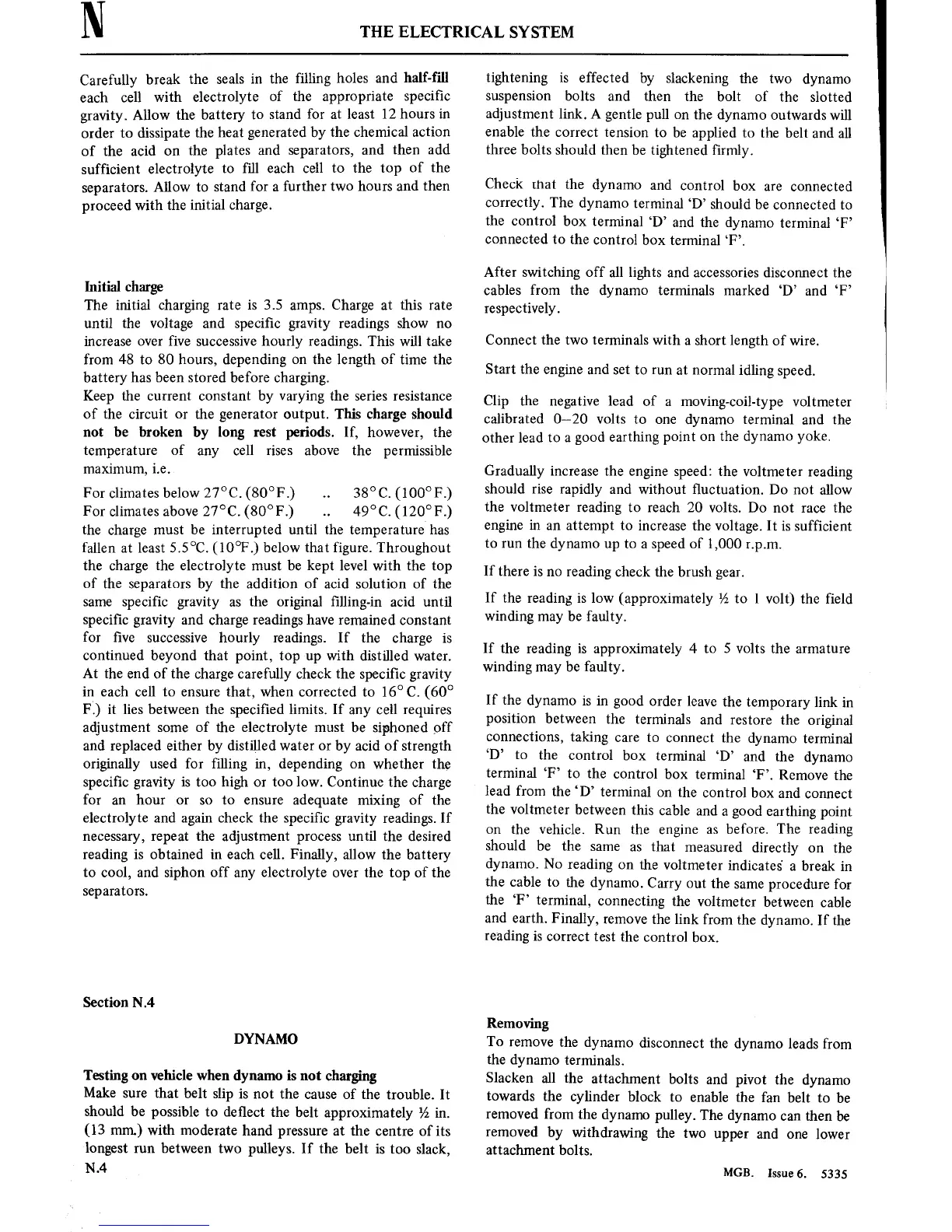N
THE ELECTRICAL SYSTEM
Carefully
break the
seals
in
the filling
holes and
half-fill
each
cell with
electrolyte
of the
appropriate
speci■c
gravity.
Allow the battery
to
stand for
at
least 12
hours
in
order
to
dissipate
the heat
generated by the
chemical
action
of
the acid
on
the
plates and
separators,
and
then add
suf■cient
electrolyte
to
■ll
each cell
to
the
top
of the
separators.
Allow
to
stand
for
a
further
two
hours
and then
proceed with
the initial charge.
Initial
charge
The
initial charging
rate
is
3.5
amps.
Charge
at
this
rate
until
the
voltage and
speci■c
gravity
readings show
no
increase
over
five
successive
hourly
readings. This will take
from
48
to
80
hours, depending
on
the length of
time
the
battery has been stored
before
charging.
Keep the
current
constant
by
varying
the
series
resistance
of
the
circuit
or
the
generator
output.
This charge should
not
be broken by long
rest
periods.
If,
however, the
temperature
of
any
cell
rises
above the
permissible
maximum, i.e.
For climates below
27°C. (80°F) 38°C. (100°F.)
For climates above
27°C. (80°F.) 49°C. (120°F.)
the charge
must
be
interrupted until the
temperature
has
fallen
at
least
55°C. (10°F)
below that
figure.
Throughout
the charge the
electrolyte
must
be kept level with the
top
of the
separators
by the
addition
of
acid solution of the
same
specific
gravity
as
the original ■lling-in
acid until
speci■c
gravity
and charge readings have remained
constant
for
■ve
successive
hourly readings. If the charge
is
continued
beyond that
point,
top
up
with distilled
water.
At
the end of the charge carefully check
the
speci■c
gravity
in
each cell
to
ensure
that, when corrected
to
16°C. (60°
F.)
it
lies
between the speci■ed limits. If
any
cell
requires
adjustment
some
of the electrolyte
must
be siphoned
off
and replaced either by distilled
water
or
by
acid
of
strength
originally used for filling
in,
depending
on
whether the
speci■c
gravity is
too
high
or
too
low. Continue the
charge
for
an
hour
or so
to
ensure
adequate
mixing
of
the
electrolyte and
again
check the specific
gravity
readings. If
necessary,
repeat
the adjustment
process
until
the desired
reading
is
obtained
in
each cell. Finally, allow
the battery
to
cool, and siphon off
any
electrolyte
over
the
top
of
the
separators.
Section
N.4
DYNAMO
Testing
on
vehicle when dynamo
is
not
charging
Make
sure
that
belt slip
is
not
the
cause
of the
trouble.
It
should
be
possible
to
de■ect
the belt
approximately 1/2
in.
(13
mm.)
with moderate
hand
pressure
at
the
centre
of
its
longest
run
between
two
pulleys. If the
belt
is
too
slack,
N.4
tightening
is
effected
by slackening the
two
dynamo
suspension
bolts and then
the bolt of
the
slotted
adjustment
link.
A
gentle
pull
on
the dynamo
outwards will
enable the
correct
tension
to
be
applied
to
the
belt and all
three bolts
should then
be tightened firmly.
Check
that
the
dynamo
and
control
box
are
connected
correctly. The
dynamo
terminal ‘D’
should
be
connected
to
the control box
terminal ‘D’
and the dynamo
terminal ‘F’
connected
to
the
control box
terminal ‘F’.
After switching
off all lights
and
accessories
disconnect the
cables from the dynamo
terminals marked ‘D’ and ‘F’
respectively.
Connect the
two
terminals with
a
short
length of
wire.
Start the
engine
and
set
to
run
at
normal idling
speed.
Clip the
negative
lead of
a
moving-coil-type voltmeter
calibrated
0—20 volts
to
one
dynamo terminal
and the
other lead
to
a
good
earthing
point
on
the dynamo yoke.
Gradually
increase
the
engine
speed: the voltmeter
reading
should
rise
rapidly and without ■uctuation.
Do
not
allow
the
voltmeter reading
to
reach
20
volts.
Do
not
race
the
engine in
an
attempt to
increase
the
voltage.
It
is
sufficient
to
run
the
dynamo
up
to
a
speed
of
1,000
rpm.
If
there
is
no
reading check
the brush
gear.
If
the reading
is
low (approximately
1/2
to
1
volt)
the
field
winding
may
be faulty.
If the reading
is
approximately 4
to
5 volts the
armature
winding
may
be faulty.
If
the
dynamo
is in
good order
leave the
temporary
link
in
position
between
the
terminals
and
restore
the
original
connections,
taking
care
to
connect
the
dynamo
terminal
‘D’
to
the
control
box
terminal
‘D’ and
the
dynamo
terminal ‘F’
to
the
control
box
terminal
‘F’.
Remove the
lead from
the
‘D’
terminal
on
the
control box
and
connect
the
voltmeter
between
this
cable
and
a
good
earthing
point
on
the vehicle. Run the
engine
as
before. The
reading
should
be
the
same
as
that
measured directly
on
the
dynamo.
No
reading
on
the
voltmeter
indicates
a
break
in
the cable
to
the
dynamo.
Carry
out
the
same
procedure for
the
‘F’
terminal,
connecting
the
voltmeter
between
cable
and
earth. Finally,
remove
the link from
the dynamo.
If
the
reading
is
correct test
the
control box.
Removing
To
remove
the
dynamo
disconnect
the
dynamo leads from
the
dynamo
terminals.
Slacken
all the
attachment
bolts
and
pivot
the
dynamo
towards
the
cylinder block
to
enable the
fan belt
to
be
removed from
the dynamo
pulley. The
dynamo
can
then
be
removed
by
withdrawing
the
two
upper
and
one
lower
attachment
bolts.
MGB.
Issue6.
5335

